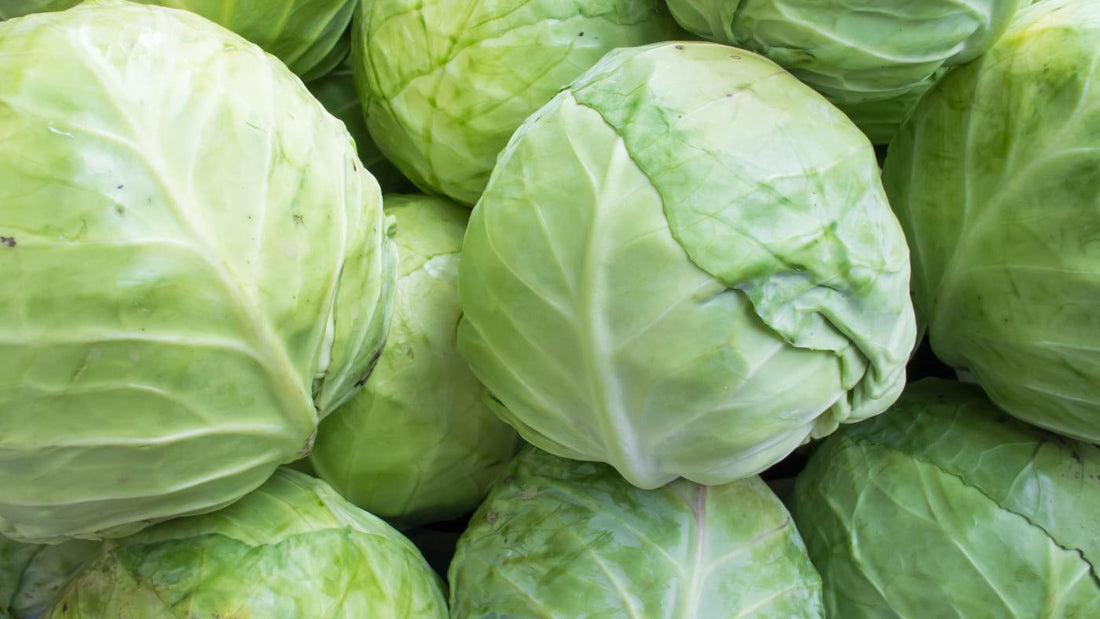Cabbage is a cruciferous vegetable closely related to kale, broccoli, cauliflower, and Brussels sprouts. Its name comes from the French word caboche, which translates to “head.” It is a member of the Brassicaceae family of plants, but its definite origin is hard to pinpoint.
Nobody knows for certain where cabbage first appeared, but a likely ancestor to modern cabbage was found growing on the rocky cliffs of Britain. The plant’s ability to retain moisture in its leaves has allowed it to grow in cold, harsh climates.
Other possible cabbage ancestors have been found in the Mediterranean and Asia Minor. But, no matter where cabbage originated, it was immensely popular in ancient Greece and China, and Medieval Europe.
In the Middle Ages, cabbage was one of the most commonly eaten foods by Europeans. It was beloved both by royalty and common folk. It was grown in Charlemagne’s royal gardens, purchased in bulk by King John II of France, and eaten in soups and stews by peasants.
It was also one of the first crops grown by English colonists in the Americas.

Over time, cabbage became a staple in cuisines around the world, and is still used today in traditional foods such as German, Scandinavian, and Dutch sauerkraut, Korean kimchi, and Irish fried cabbage!
Not only does cabbage lend itself to dozens of amazing recipes, but it is also packed with nutrients and vitamins that have outstanding health benefits. Incorporating more of this superfood into your diet can improve your heart health, ease inflammation, and even boost concentration.
Keep reading to learn more about how cabbage can improve your health!

Cabbage boosts your immunity
Being a great source of vitamin C, cabbage is great for boosting and maintaining a strong immune system. Vitamin C increases the production of infection-fighting white blood cells and strengthens the skin’s barriers to prevent bacteria from invading the body.
Vitamin C is also known for shortening the time it takes for wounds to heal, and for illness to go away. Amazingly, just one cup of cabbage contains 54% of the recommended daily intake of vitamin C!
Cabbage improves digestion
Adding more cabbage to your diet keeps your gut healthy and promotes regular bowel movements. That’s thanks to cabbage’s insoluble fiber content. This fiber moves through the intestines and cleans them out as they go. This allows for food to be digested more easily and can reduce the risk of constipation.
Besides that, soluble fiber can also lower “bad” LDL cholesterol levels. 40% of the fiber in cabbage is soluble fiber.
Cabbage strengthens your bones
Just one cup of raw green cabbage contains 85% of the recommended daily intake of vitamin K, a vitamin responsible for maintaining strong bones, improving bone density, and reducing the risk of bone fracture.
The benefits of vitamin K don’t stop there. Vitamin K improves cognitive health in older adults, and keeps blood pressure low, lowering the risk of heart disease and stroke.

Before you buy cabbage, you’ll want to know which variety of cabbage you’re looking for: red or green. Both varieties have their unique color, taste, and nutritional content.
Red cabbage has a dark purple color and a bold taste. It is often described as peppery and floral. In comparison to green cabbage, red cabbage contains about 10 times more vitamins and antioxidants, making it the healthier option of the two.

Green cabbage has a mild, watery flavor that gets sweeter as it cooks. It may generally have a smaller vitamin content than red cabbage, but not when it comes to vitamin K. Green cabbage contains almost double the amount of vitamin K as red cabbage!
Whichever cabbage variety you choose to buy, always look for a dense and firm head. The outer leaves should be crisp and vibrant. Brown, wilting outer leaves are a signal that cabbage is past its prime.
Fresh cabbage should be very hydrated, and you can check this by picking it up. If it feels slightly heavy for its size, this tells you that it's well-hydrated and ready to be eaten.
To keep cabbage fresh once you’ve brought it home, store it in a large zip-top bag in the refrigerator. An uncut head of cabbage can last in the fridge for up to two months.

Cabbage may not have the reputation of being the most loved vegetable on the dinner table these days, but when incorporated into deliciously nutritious recipes, it won’t take long until that reputation rings true.
One of the most classic cabbage recipes is, of course, corned beef and cabbage — a staple on St. Patrick’s Day. The tender slices of beef brisket and boiled potatoes, carrots, and savory cabbage is a wonderful, aromatic combination. Serve with horseradish and mustard sauce to elevate the flavor even more!

Cabbage also goes great in soups and stews. For a simple, yet hearty meal you can make for big groups, make beef and cabbage stew. Just put your ingredients, including desired vegetables, into a pot and let simmer until everything is tasty and tender.
If you’re looking for a tasty cabbage side dish to make for big dinners or potlucks, try cabbage and green beans. Just let chopped red cabbage and green beans simmer — for 5 minutes and 15 minutes respectively. For added flavor, stir in chopped bacon!
The healthiest way to serve up your cabbage, however, is in a salad. Excessive heat drains vegetables of their nutrient content, meaning eating them raw will always be more beneficial to your health.
Shredded cabbage is easy to add to any salad recipe. It’ll not only make the salad better for you, but its vibrant color will make it look nicer too.
No matter how you choose to integrate cabbage into your diet, your body will thank you!

